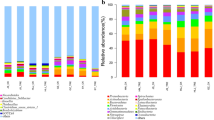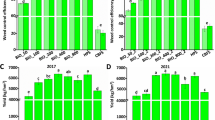Abstract
Purpose
Soil microorganisms directly affect the growth of plants. Especially, plant growth-promoting rhizobacteria (PGPR) play an important role in plant growth. There are many studies about the effects of different fertilization treatments on soil microbial community structure; however, the effects on PGPR, including indole-3-acetic acid (IAA)-producing bacteria have not been previously reported. The objective of this study is to determine the effects of different types of fertilizers on IAA-producing bacteria.
Materials and methods
The field trial was completed in the North China with a winter wheat and summer corn rotation system. IAA-producing bacteria were screened from soil treated with different fertilizer (non-nitrogen fertilizer (CK), controlled-release fertilizer (CR), chemical fertilizer (CF), and organic fertilizer (OF)) which was established in September 2005. Quantity of IAA produced by bacteria was determined by spectrophotometer. IAA-producing bacteria were identified based on 16S rDNA sequence. Community structures and phylogenetic relationships of IAA-producing bacteria were analyzed by online Basic Local Alignment Search Tool search engine, biosoftware of DNAMAN and Molecular Evolutionary Genetics Analysis.
Results and discussion
Compared with CK treatment, CF and CR treatment increased soil pH values, while OF treatment decreased pH. The three types of fertilizers all increased soil organic carbon and total nitrogen, with OF treatment causing the significant increase. Soils treated with OF or CR fertilizer could significantly increase the number of culturable bacteria compared with CF or CK treatment. Fifty-three IAA-producing bacteria (14 strains from CK, nine from CF, eight from CR, and 22 from OF) were identified based on 16S rDNA sequence. The Shannon–Weiner index of IAA-producing bacteria isolated from CK and OF (2.06 and 2.45, respectively) was significantly higher than those from CF and CR (0.50 and 0.95, respectively). Arthrobacter sp. was the most prevalent group of IAA-producing bacteria.
Conclusions
The fertilizers increased soil organic carbon and total nitrogen, particularly the organic fertilizers. Controlled-release fertilizers and organic fertilizers can promote growth of soil-culturable bacteria and IAA-producing bacteria. These may be reasons why organic fertilizers and controlled-release fertilizers can promote crop growth. Different fertilization treatments affected IAA yield mainly through modifying the quantities of microorganisms, rather than changing the IAA-producing ability of the same microorganisms. Pedobacter sp. which can produce IAA has not been described previously.


Similar content being viewed by others
References
Ahamadou B, Huang Q, Chen W, Wen S, Zhang J, Mohamed I, Cai P, Liang W (2009) Microcalorimetric assessment of microbial activity in long-term fertilization experimental soils of Southern China. FEMS Microbiol Ecol 70:186–195
Ali B, Sabri AN, Hasnain S (2010) Rhizobacterial potential to alter auxin content and growth of Vigna radiata (L.) World J Microbiol Biotechnol 26:1379–1384
Appunu C, Sasirekha N, Prabavathy VR, Nair S (2009) A significant proportion of indigenous rhizobia from india associated with soybean (Glycine max L.) distinctly belong to Bradyrhizobium and Ensifer genera. Biol Fertil Soils 46(1):57–63
Bianco C, Defez R (2009) Medicago truncatula improves salt tolerance when nodulated by an indole-3-acetic acid-overproducing Sinorhizobium meliloti strain. J Exp Bot 60(11):3097–3107
Cai Y, Liao Z, Je H, Kong W, He C (2003) Effect of ecological organic fertilizer on tomato bacterial wilt and soil microbial diversities (in Chinese). J Appl Ecol Sin 14(3):349–353
Chapin FS, Matson PA, Mooney HA (2002) Principles of terrestrial ecosystem ecology. Springer, New York, pp 200
Cho SJ, Lee SK et al (2003) Detection and characterization of the Gloeosporium gloeosporioides growth inhibitory compound iturin A from Bacillus subtilis strain KS03. FEMS Microbiol Lett 223(1):47–51
Egamberdieva D (2008) Plant growth promoting properties of rhizobacteria isolated from wheat and pea grown in loamy sand soil. Turk J Biol 32:9–15
Enwall K, Philippot L, Hallin S (2005) Activity and composition of the denitrifying bacterial community respond differently to long-term fertilization. Appl Environ Microbiol 71(12):8335–8343
FAO/UNESCO (1988) Soil map of the world. Revised legend. FAO, Rome
Ferreira MI, Marchesi JR, Janssen DB (2008) Degradation of 4-fluorophenol by Arthrobacter sp. strain IF1. Appl Microbiol Biotechnol 78(4):709–717
Forni C, Riov J, Grilli Caiola M, Tel-Or E (1992) Indole-3-acetic acid (IAA) production by Arthrobacter species isolated from azolla. J Gen Microbiol 138(2):377–381
He JZ, Zheng Y, Chen CR, He YQ, Zhang LM (2008) Microbial composition and diversity of an upland red soil under long-term fertilization treatments as revealed by culture-dependent and culture-independent approaches. J Soils Sediments 8:349–358
Huddedar SB, Shete AM, Tilekar JN, Gore SD, Dhavale DD, Chopade BA (2002) Isolation, characterization, and plasmid pUPI126-mediated indole-3-acetic acid production in Acinetobacter strains from rhizosphere of wheat. Appl Biochem Biotechnol 102–103(1–6):21–39
Idris EE, Iglesias DJ, Talon M, Borriss R (2007) Tryptophan-dependent production of indole-3-acetic acid (IAA) affects level of plant growth promotion by Bacillus amyloliquefaciens FZB42. Mol Plant Microb Interact 20(6):619–626
Jones D, Keddie R (2006) The genus Arthrobacter. In: The prokaryotes. Springer: New York, pp 945–960
Li F, Ping S, Su B, Lin M (2000) Tn5 mutagenesis and the characteristics of indole-3-acetic acid biosynthesis in Alcaligenes faecalis A1501 (in Chinese). Acta Microbiol Sin 40(5):551–555
Liu ST, Kado CI (1979) Indoleacetic acid production: a plasmid function of Agrobacterium tumefaciens C58. Biochem Biophys Res Commun 90(1):171–178
Liu XZ, Zhang LM, Prosser JI, He JZ (2009) Abundance and community structure of sulfate reducing prokaryotes in a paddy soil of southern China under different fertilization regimes. Soil Biol Biochem 41:687–694
Loper JE, Schroth MN (1986) Influence of bacterial sources of indole-3-acetic acid on root elongation of sugar beet. Physiol Biochem 76:386–389
Lottmann J, Heuer H, Smalla K, Berg G (1999) Influence of transgenic T4-lysozyme-producing potato plants on potentially beneficial plant-associated bacteria. FEMS Microbiol Ecol 29(4):365–377
Marschner P, Kandeler E, Marschner B (2003) Structure and function of the soil microbial community in a long-term fertilizer experiment. Soil Biol Biochem 35(3):453–461
Mew T, Ho W, Chu L (1976) Infectivity and survival of soft-rot bacteria in Chinese cabbage. Phytopathol 66:1325–1327
Mongodin EF, Shapir N, Daugherty SC, DeBoy RT, Emerson JB, Shvartzbeyn A, Radune D, Vamathevan J, Riggs F, Grinberg V, Khouri H, Wackett LP, Nelson KE, Sadowsky MJ (2006) Secrets of soil survival revealed by the genome sequence of Arthrobacter aurescens TC1. PLoS Genet 2(12):e214
Ortiz-Castro R, Contreras-Cornejo HA, Macias-Rodriguez L, Lopez-Bucio J (2009) The role of microbial signals in plant growth and development. Plant Signaling & Behavior 4(8):701–712
Palmroth MRT, Koskinen PEP, Pichtel J, Vaajasaari K, Joutti A, Tuhkanen TA, Puhakka JA (2006) Field-scale assessment of phytotreatment of soil contaminated with weathered hydrocarbons and heavy metals. J Soils Sediments 6(3):128–136
Patten C, Glick B (1996) Bacterial biosynthesis of indole-3-acetic acid. Can J Microbiol 42(3):207–220
Patten C, Glick B (2002a) Regulation of indoleacetic acid production in Pseudomonas putida GR12-2 by tryptophan and the stationary-phase sigma factor RpoS. Can J Microbiol 48(7):635–642
Patten C, Glick B (2002b) Role of Pseudomonas putida indoleacetic acid in development of the host plant root system. Appl Environ Microbiol 68(8):3795–3801
Persello-Cartieaux F, Nussaume L, Robaglia C (2003) Tales from the underground: molecular plant-rhizobacteria interactions. Plant Cell Environ 26(2):189–199
Prinsen E, Costacurta A, Michiels K, Vanderleyden J, Van Onckelen H (1993) Azospirillum brasilense indole-3-acetic acid biosynthesis: evidence for a non-tryptophan dependent pathway. Mol Plant Microb Interact 6:609–615
Šimek M, Hopkins DW, Kalčík J, Picek T, Šantrůčková H, Staňa J, Trávník K (1999) Biological and chemical properties of arable soils affected by long-term organic and inorganic fertilizer applications. Biol Fertil Soils 29(3):300–308
Slininger PJ, Burkhead KD, Schisler DA (2004) Antifungal and sprout regulatory bioactivities of phenylacetic acid, indole-3-acetic acid, and tyrosol isolated from the potato dry rot suppressive bacterium Enterobacter cloacae S11:T:07. J Ind Microbiol Biotechnol 31(11):517–524
Spaepen S, Vanderleyden J, Remans R (2007) Indole-3-acetic acid in microbial and microorganism plant signaling. FEMS Microbiol Rev 31(4):425–448
Sun R (2002) Basic ecology (in Chinese). Higher Education Press, Beijing, p 144
Tamura K, Dudley J, Nei M, Kumar S (2007) MEGA4: molecular evolutionary genetics analysis (MEGA) software version 4.0. Mol Biol Evol 24(8):1596–1599
Vestergård M, Bjørnlund L, Henry F, Rønn R (2007) Decreasing prevalence of rhizosphere IAA producing and seedling root growth promoting bacteria with barley development irrespective of protozoan grazing regime. Plant Soil 295(1):115–125
Weisskopf L, Fromin N, Tomasi N, Aragno M, Martinoia E (2005) Secretion activity of white lupin’s cluster roots influences bacterial abundance, function and community structure. Plant Soil 268(1):181–194
Woodward AW, Bartel B (2005) Auxin: regulation, action, and interaction. Ann Bot 95:707–735
Xu Y, Zhao Z, Zhang F, Liu J (2007) Advances in development and application of controlled-release fertilizers (in Chinese). Acta Agriculturae Boreali-Sinica 22(supplement):190–194
Acknowledgments
This work was supported by the Specialized Research Fund for Doctor Program in University (20090008120043), China Agricultural University Basic Research Fund (2009JS108), Special Fund for Agro-scientific Research in the Public Interest (200803033), and China International Science and Technology Partnership Program (2009DFA91790).
Author information
Authors and Affiliations
Corresponding author
Additional information
Responsible editor: Ji-Zheng He
Rights and permissions
About this article
Cite this article
Yuan, CL., Mou, CX., Wu, WL. et al. Effect of different fertilization treatments on indole-3-acetic acid producing bacteria in soil. J Soils Sediments 11, 322–329 (2011). https://doi.org/10.1007/s11368-010-0315-2
Received:
Accepted:
Published:
Issue Date:
DOI: https://doi.org/10.1007/s11368-010-0315-2




